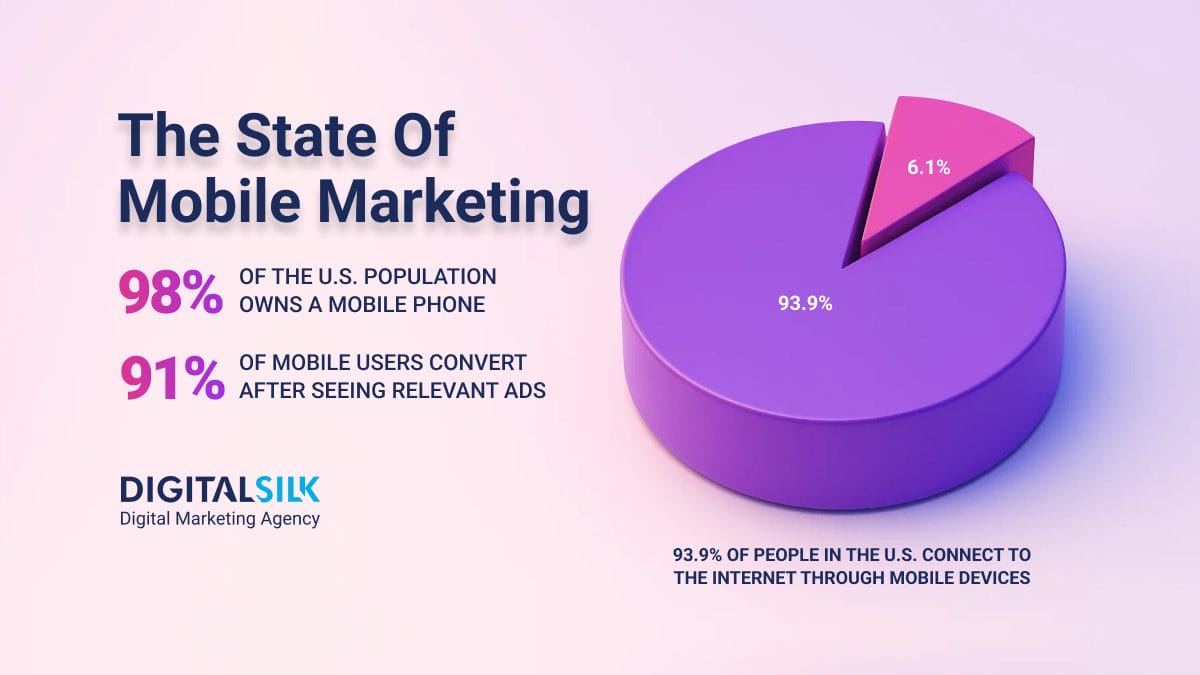508-Compliant Website: Key Highlights
-
Accessibility defines trust: When public websites are intuitive and inclusive, they reflect real accountability and strengthen confidence in government communication.
-
Keyboard navigation is non-negotiable: Every visitor should be able to reach information and complete tasks without relying on a mouse.
-
Remove triggers and time barriers: Eliminating flashing visuals and rigid time limits protects users with sensory or cognitive sensitivities.
Imagine a citizen trying to access vital public information, only to find the website impossible to navigate when it matters most.
It’s a scenario that unfolds every day, with 88% of websites still failing to meet accessibility standards and leaving entire communities behind.
For public agencies, accessibility defines credibility, efficiency and genuine care for the people they serve.
This post uncovers 8 secrets for building a 508 compliant website that reflects your agency’s commitment to transparency, innovation and meaningful digital access for all.
8 Secrets To Make Your Website 508 Compliant
Government agencies are expected to lead by example in creating accessible and inclusive digital experiences.
The Section 508 compliance checklist below provides a clear framework to meet those expectations, ensuring every aspect of a website supports usability, compliance and public trust.
1. Ensure Full Keyboard Navigation
Exploring online content should be simple, yet for millions of Americans it often isn’t.
More than 28.7% of adults in the United States have a disability, with cognitive disabilities being the most common at 13.9%.
Those individuals rely on their keyboards to access vital public information and digital services.
When websites fail to support full keyboard navigation, they create barriers that exclude users and fall short of what a 508-compliance website is designed to achieve.
To make your website fully accessible through keyboard navigation, focus on these key actions:
- Make all interactive elements like links, buttons, menus and forms accessible using Tab, Shift + Tab, Enter, Space and arrow keys.
- Include visible focus indicators so users can easily track their position on each page.
- Remove navigation traps that prevent users from moving forward or backward without a mouse.
- Arrange tab order logically to match how the content appears visually and flows naturally.
- Test regularly with assistive technologies and real users to uncover and resolve accessibility gaps before they impact the public.
One of the most effective 508 compliance examples can be seen on the U.S. Department of Agriculture (USDA) website, where tab navigation is fully supported and highlights key areas as users move through the page.

Each interactive element, from menus to buttons like Find Staff Offices, can be accessed without a mouse, allowing users to explore services and information efficiently without relying on a mouse.
2. Add Descriptive Alt Text For Images And Videos
Across the public sector, accessibility standards are being reinforced by growing legal accountability.
Legal compliance is the leading reason why 26.1% of global organizations are prioritizing digital accessibility, while 43% of U.S. organizations have faced some form of legal action for accessibility-related issues.
Incorporating descriptive alt text is a key part of 508 compliance for websites, allowing users who rely on screen readers to understand images and visuals as clearly as those who can see them.
Well-written alt text communicates purpose and context, turning visual elements into accessible content and reducing the risk of accessibility violations.
Effective ways to apply descriptive alt text include:
- Write clear, specific descriptions that explain what the image shows or why it’s important.
- Describe the purpose of linked images, such as “Download annual report” or “Open application form.”
- Use empty alt text (alt=””) for decorative visuals so screen readers move smoothly through the page.
- Add short descriptions for charts or infographics and link to a page with full details for complex data.
- Review alt text regularly to keep new images, banners and icons consistent with accessibility standards.
For instance, the National Institutes of Health (NIH) website demonstrates effective use of descriptive alt text, ensuring that each image adds context and remains accessible to users relying on screen readers.
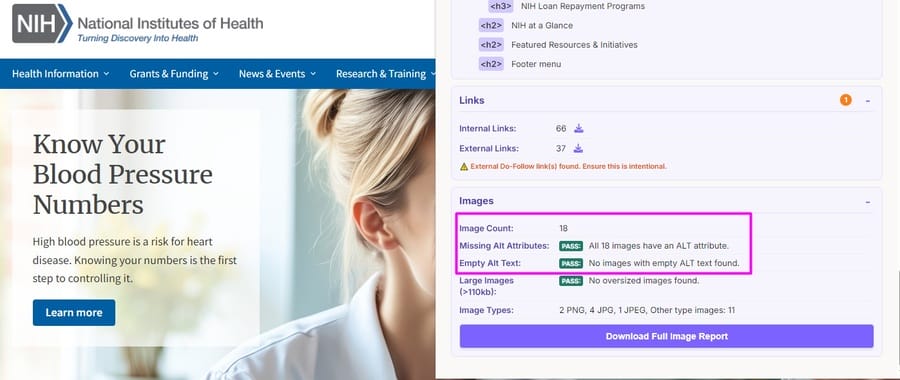
You can use the Smart SEO Highlighter extension to check alt tags on similar websites and verify whether all images include proper attributes without missing or empty descriptions.
3. Provide Transcripts And Captions For Multimedia
Public communication relies heavily on spoken updates, press briefings and video content to inform and engage citizens.
Over 5% of the world’s population, or roughly 430 million people, require rehabilitation for disabling hearing loss.
By 2050, nearly 2.5 billion are expected to experience some degree of hearing loss, with more than 700 million needing rehabilitation.
Having a 508-compliant website ensures this information is accessible through accurate transcripts and captions that convey every spoken word and sound cue.
Providing these text alternatives allows every visitor to access the same information, regardless of hearing ability or environment.
To ensure multimedia accessibility, focus on these practices:
- Add accurate closed captions to all videos with audio so dialogue and sound cues appear in sync with visuals.
- Identify speakers and describe relevant sounds to ensure full understanding of context and tone.
- Include downloadable transcripts for recorded materials such as webinars, announcements or podcasts for easy reference and translation.
- Use professional captioning services or verified tools to maintain accuracy, especially for technical or policy-based content.
- Regularly review and update captions to confirm synchronization, clarity and compliance with accessibility standards.
The U.S. Patent and Trademark Office (USPTO) provides a good example of accessible multimedia through its Innovation Festival video, which includes clear, synchronized captions for all spoken narration.
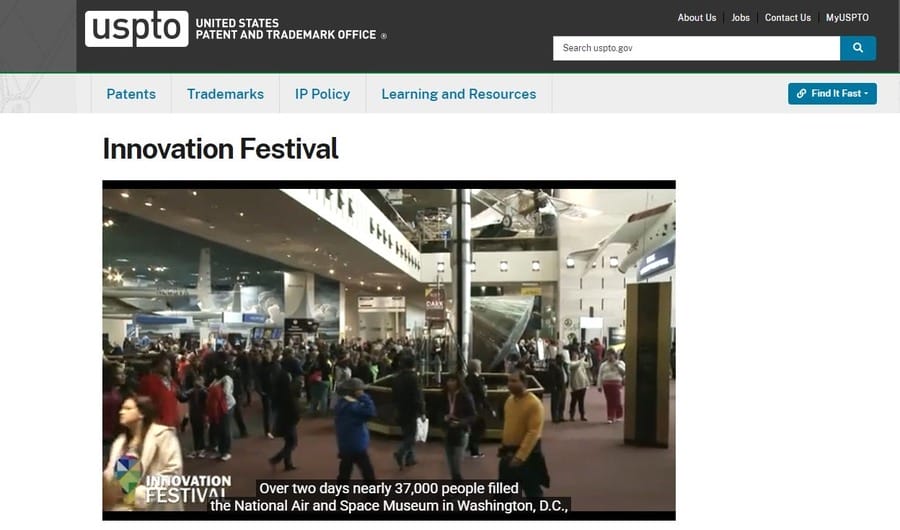
The captions accurately reflect both dialogue and context, allowing users with hearing impairments to follow along with the story and key details about the event.
This approach aligns with best practices for accessible multimedia, ensuring that important public content remains available to every viewer.
4. Design For Screen Reader Compatibility
As digital access expands, usability depends on how effectively a website communicates beyond the visual layer.
62% of Americans with disabilities have access to high-speed internet, which means they are actively engaging with online information and services.
A well-designed Section 508 compliance website ensures that this growing audience can navigate content using screen readers without confusion or interruption.
Building compatibility through proper structure, accessible rich internet applications (ARIA) roles and descriptive labels turns complex pages into clear, navigable experiences for users who rely on assistive technology.
Consider these approaches to ensure compatibility with screen readers:
- Use proper ARIA roles and labels to define the purpose of elements like buttons, forms and navigation menus.
- Avoid empty links and unlabeled buttons that leave screen reader users without context or direction.
- Write clear, descriptive headings and page titles so screen readers can organize and announce content logically.
- Ensure form fields have clear instructions and error messages that can be read aloud by assistive tools.
- Test regularly with screen readers such as NVDA and JAWS to identify barriers and confirm that interactive elements behave as expected.
5. Remove Time Limits And Flashing Elements
Accessible design protects users from unnecessary barriers, especially when time or motion interfere with how they process information.
Almost 3 million U.S. adults have epilepsy, and exposure to flashing or flickering elements can trigger seizures or severe discomfort.
Time limits create another accessibility obstacle, often preventing users with cognitive or motor disabilities from completing tasks at their own pace.
The following steps help eliminate these barriers and contribute to a 508-compliance accessible website:
- Avoid flashing or flickering elements that blink more than three times per second, as these can trigger seizures or disorientation.
- Keep all flashing or blinking content outside the 2 to 55 hertz frequency range to prevent seizure risks.
- Eliminate time limits on forms or interactive tasks so users can complete actions at their own pace.
- Provide clear on-screen notifications if a time restriction is unavoidable, along with an option to extend the session.
- Disable autoplay for videos, sliders and animated banners to prevent visual overload or distraction.
- Offer a non-animated viewing mode or motion-reduction toggle for users sensitive to movement or flashing visuals.
For example, the Transportation Security Administration (TSA) website features auto-scrolling, timed horizontal animations that rotate through key topics such as Families on the Fly and Easy Travel Tips.

The transitions are smooth and well-paced, guiding users through information without abrupt motion or visual strain.
6. Use High-Contrast Colors And User-Friendly Fonts
Color and typography determine how easily citizens can find, read and understand the information their communities rely on.
Out of 94.8% of homepages with WCAG 2 failures, low-contrast text accounts for 79.1%, showing how often accessibility breaks down when readability isn’t a design priority.
A 508-compliance website uses high-contrast color combinations and clear, consistent fonts to make sure every policy update, notice and resource remains visible to everyone.
Practical ways to achieve color and font accessibility include:
- Maintain a minimum contrast ratio of 4.5:1 for body text and 3:1 for large text to ensure content is clearly visible against its background.
- Use tools like WebAIM’s Contrast Checker to test color combinations before publishing new pages or updates.
- Avoid using color alone to convey meaning by pairing visual cues with descriptive text or icons.
- Choose clean, readable fonts like Arial, Helvetica or Open Sans that display well across devices and screen resolutions.
- Set body text at 16px or larger with at least 1.5x line spacing to support easy reading for users with visual or cognitive impairments.
- Regularly review color and font accessibility in audits to ensure new design updates remain compliant and user-friendly.
The Centers for Disease Control and Prevention (CDC) website is among the more effective 508 compliance examples, using high-contrast blue and white tones that make text and buttons stand out clearly against background images.
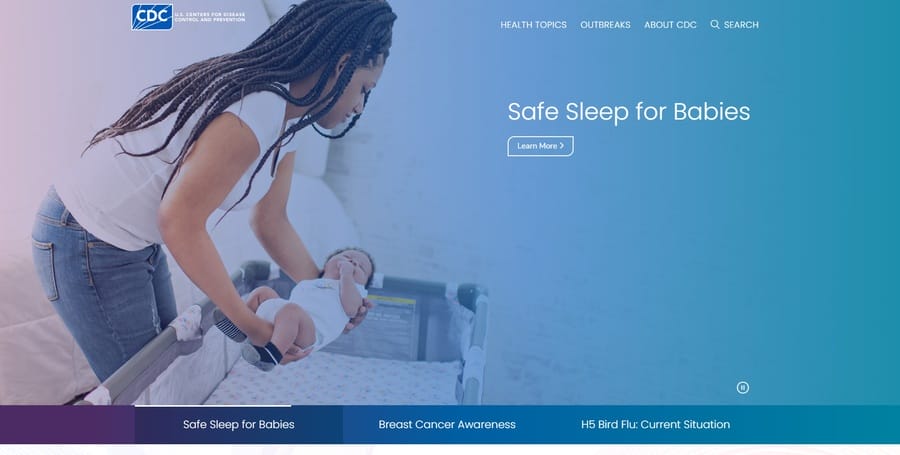
Its sans-serif fonts maintain readability across health topics and resource pages, allowing users to navigate and absorb information with ease.
7. Build Accessible Forms And Error Messages
Forms connect people to vital digital services, from renewing licenses to requesting public records.
Through 508 compliance for websites, forms should be designed so every user can enter, review and submit information without barriers, including those using assistive technologies.
Each field needs a clear label and concise instruction that explains what information is required, while error messages must point out the issue and guide users toward a fix.
To design accessible and user-focused forms, follow these best practices:
- Label every input field clearly and connect each label to its form element so assistive technologies can read them properly.
- Make validation messages accessible by ensuring they appear visually and are announced by screen readers.
- Write direct, specific error messages that explain what went wrong and how to correct it.
- Allow browsers to pre-fill common fields like name, email or address to save time and reduce effort.
- Ensure scripts and dynamic form elements work seamlessly with assistive tools so users can complete and submit forms without obstacles.
For instance, the U.S. Government Publishing Office (GPO) inquiry form illustrates accessible design through clearly labeled fields, required indicators and user-first instructions.
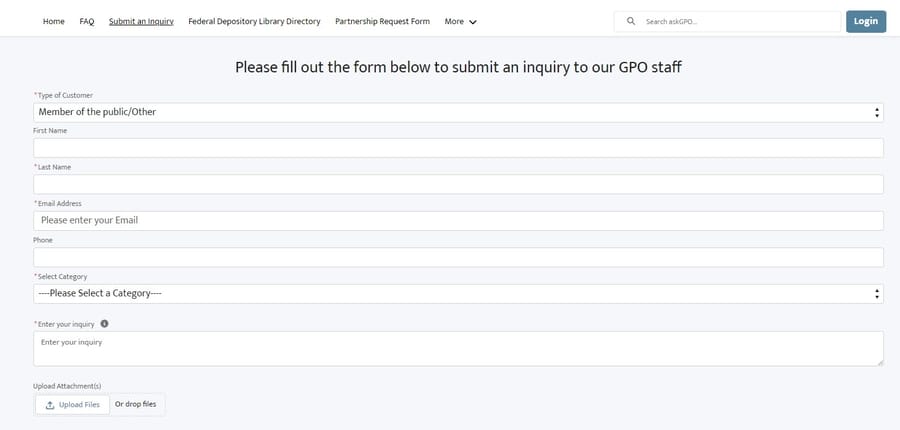
Each input is paired with a descriptive label, allowing screen readers to announce form elements accurately.
The structure and spacing make the form easy to follow, supporting usability for all visitors, including those using assistive technologies.
8. Continuous Monitoring & Governance Policies
You should treat accessibility as more than a one-time achievement, as it’s an ongoing standard of public service.
New content, system updates and design enhancements can unintentionally introduce accessibility issues.
Governance processes ensure your website remains 508-compliant as technology, policies and user expectations evolve.
Follow these practices to maintain compliance over time:
- Establish a quarterly accessibility audit process using automated and manual testing methods
- Track key accessibility performance indicators (KPIs) such as keyboard navigation success rate, form completion success or time-to-information for users with disabilities
- Require 508 compliance review for every new page, content update or digital release
- Create an internal accessibility champion role or cross-department review team
- Maintain updated accessibility statements and response procedures for public complaints
- Train staff and content authors regularly to prevent future violations
Proactivity reduces remediation costs, improves trust and ensures your 508-compliant website continues to serve every citizen effectively.
Why Section 508 Compliance Matters For Public Agencies
Section 508 compliance ensures that every digital interaction is accessible, lawful and aligned with public service values.
The following points highlight how accessibility impacts policy, reputation and operational integrity across government platforms:
- Legal responsibility: Compliance with the Americans with Disabilities Act (ADA) and Section 508 ensures equal access to digital information and protects agencies from violations and penalties.
- Public perception: Accessible websites build transparency and demonstrate genuine care for citizens’ needs, strengthening trust in government communication.
- Implementation progress: 78% of government entities reported conducting Section 508 conformance testing on their public websites, yet only 61% of tested pages were fully conformant, revealing significant room for improvement.
- Complaint management gaps: About 44% of agencies lack formal written procedures to handle accessibility complaints, leaving potential risks unresolved.
- Legal and funding implications: Noncompliance can result in lawsuits or jeopardize access to federal funding tied to accessibility mandates.
- Operational efficiency: Embedding accessibility into digital design reduces long-term remediation costs and improves usability for all users, including those with temporary or situational limitations.
- Public accountability: Meeting accessibility standards reinforces an agency’s commitment to fair governance and reliable public service delivery.
Common Risks Associated With Section 508 Compliance Failure
Ignoring accessibility standards has consequences that reach far beyond technical compliance.
Understanding the risks helps prioritize accessibility as a lasting investment in trust and accountability:
- Legal and regulatory action: Failure to comply can result in lawsuits, formal complaints or investigations under federal accessibility laws.
- Funding restrictions: Agencies that fail to meet accessibility requirements may lose eligibility for certain grants or contracts tied to compliance.
- Public perception damage: Accessibility gaps can create the impression of neglect, weakening the agency’s reputation and public confidence.
- Operational setbacks: Fixing accessibility issues after launch is far more time-consuming and costly than addressing them during development.
- Inconsistent service delivery: Users unable to access digital services experience delays and inequities that undermine the agency’s core purpose.
- Staff inefficiency: Internal systems that are not accessible can limit productivity and exclude employees who rely on assistive technologies.
Create A 508-Compliant Website With Digital Silk
True accessibility isn’t achieved through compliance checklists but through the intention to serve everyone equally.
When digital experiences are inclusive, public agencies remove barriers, build trust and create lasting value in how citizens engage with government services.
Digital Silk can help public agencies build a 508-compliant website that meets every accessibility standard while reflecting transparency, usability and innovation at every level of design.
As a full-service web design agency, we offer:
We take ownership of the entire process, delivering measurable results through structured oversight and transparency.
Contact our team, call us at (800) 206-9413 or fill in the Request a Quote form below to schedule a consultation.
"*" indicates required fields








